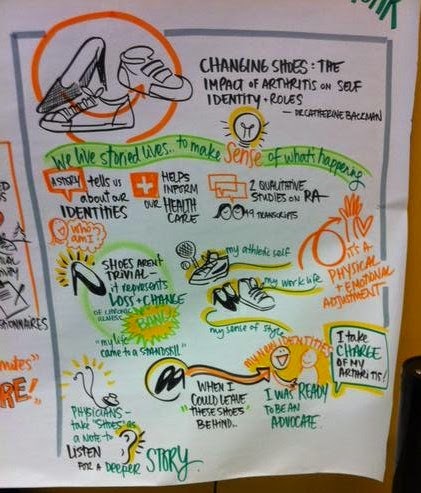My ambition for 2014 was to be a Medicine X ePatient Scholar and to have a Walking Gallery jacket done by Regina Holliday. Both of those things happened in 2014, and I appreciate and would like to thank my social media and online friends with being an amazing help throughout the year. I'd also like to thank Regina Holliday for her great insight, and for inspiring people to think in pictures.
MedX was inspiring, exhilarating, intense and a huge chance to grow as an advocate and connect with like minded people. The jacket, with great timing, arrived in Palo Alto for the first day of the MedX conference. So much happened in those four short days.
Here's a picture of the jacket - it tells the story of my first years with RA and without a diagnosis.
Walking Gallery jacket by Regina Holliday - It's A Mystery
"It's A Mystery" is inspired partly by my life-long love of mystery books, especially those from the "Golden Age" of mystery. The front covers of the books from that time, and the mood in them is still unmistakeable. That's the Toronto skyline in the background, with the CN Tower acting as the tent pole, or the beacon.
The doctor is a shadowy figure - if he knew the diagnosis it didn't help me much.
His final piece of advice: "Take 12 aspirins a day and come back in three months" led me to see another doctor when that didn't help. Regina did a great job of bringing those times to life.
His final piece of advice: "Take 12 aspirins a day and come back in three months" led me to see another doctor when that didn't help. Regina did a great job of bringing those times to life.
There I am lying on the ground with huge fatigue and two little boys, while my feet are so sore I can hardly walk. At the time I credited Diet Coke with the sudden weight loss. The doctor's explanation for the pain - "You're a busy mom."
This disappointing beginning to a story of life with chronic illness was what caused me to start to question my role as a patient and my relationship with doctors. With the story laid out so clearly on my back, I can use the circumstances of my non-diagnosis as a starting point. One thing I know - If things had gone better when I first had symptoms there would have been no impetus for me to be involved in health advocacy now.
With the story of my disappointment with a failure in healthcare is on my back when I wear the jacket, but that's the starting point. With it as a springboard I can easily talk about the passion I have now for the inclusion of the patient voice in decision making in health care.
With the story of my disappointment with a failure in healthcare is on my back when I wear the jacket, but that's the starting point. With it as a springboard I can easily talk about the passion I have now for the inclusion of the patient voice in decision making in health care.
Since I've been home from MedX I will swear that the idea of the "MedX Halo" is not a myth. I've been to six rewarding and interesting conferences since then, and have three scheduled for 2015. Working hard to learn more and advance the idea that the patient voice should be included at the decision making level in health care has been satisfying and the rewards outweigh the efforts.
We're a long way from seeing inclusion of patients as a common practice, but if we work together persistently we can advance change. I like this Margaret Mead quote:
"Never doubt that a small group of thoughtful committed citizens can change the world; indeed, it's the only thing that ever has."
In 2013 the National Forum on Patient Experience did not include patients. In 2014 there were many patients. That was a success.
In 2015 there is a conference coming up called Canadian Patient Relations Conference: Making the Invisible, Visible: Hearing the Patient Family and Caregiver Voice. There will actually be one patient in attendance - giving a keynote speech. That should be enough for patients, right?
Being a member of the Society For Participatory Medicine is another excellent way to attempt to keep up with the issues of participatory medicine and patient empowerment.
MedX ePatient Scholars & Student Leaders by @Hurtblogger
The Society for Participatory Medicine is a 501(c)(3) not-for-profit organization devoted to promoting the concept of participatory medicine, a movement in which networked patients shift from being mere passengers to responsible drivers of their health, and in which providers encourage and value them as full partners.





















